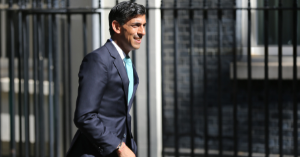Truss overtakes Mordaunt on the final lap to make the final two and starts run-off as favourite
Tory MPs have chosen Rishi Sunak and Liz Truss as the final two candidates to face the party’s 160,000 or so members. In eliminating Penny Mordaunt, who up until that point had been in the top two on every previous ballot, Tory MPs guaranteed the next Prime Minister will be someone explicitly tied to Johnson’s record and policies. Mordaunt would have been more of a gamble given her relative lack of top-level political experience – and this showed at times over the past two weeks – but she also offered the best chance of a post-Johnson reset.
Although Sunak won the support of 137 MPs to Truss’ 113 (with Mordaunt on 105), the Foreign Secretary goes into the members’ stage of the contest as the favourite. A YouGov poll of Tory members released earlier this week gives her a commanding 19-point lead (54% to 35%). It is worth noting that polling of members in recent Conservative and Labour leadership contests has generally been reliable.
Not that long ago, Sunak was the heir apparent to Johnson, with sky-high ratings among both Tory party members and the wider public as he spent billions to support households and businesses through the pandemic. However, his insistence on putting up taxes to cover this emergency spending is unpopular with his party, while his role in ousting Johnson has earned Sunak the enmity of Johnson’s diehard supporters.
Ironically, despite backing Brexit in 2016, Sunak has come to be characterised as a ‘Remainer’ given his more cautious political instincts whereas Truss, who supported Remain, now backs Brexit with the zeal of a convert, which allowed her to consolidate support on the party’s right wing.
Contest set to be dominated by divisions on economic policy and personality
Economic issues are set to play a crucial dividing line in the contest. Both candidates are running on an explicitly Thatcherite platform, albeit with different interpretations of her legacy. Sunak’s emphasis on fiscal responsibility and need to be honest with the electorate about tough economic choices evokes Thatcher’s first term in office, whereas Truss’ emphasis on radical economic reforms, tax cuts and adopting a tough posture on the international stage evokes Thatcher’s later years after she had consolidated power. Truss’ pitch is that while she takes the UK’s debt burden seriously, emergency pandemic spending should be seen more as ‘wartime debt’ and paid down over a longer period.
Sunak will be hoping that members’ views are not yet fixed and that shifting the focus of the contest from who has the most appealing policies to who is best placed to win the coming general election will benefit him. This is where personality will play a crucial role, with Sunak looking to paint Truss as a chaotic and eccentric figure, a Conservative version of Jeremy Corbyn, with positions that may inspire the party faithful, but fall flat with the wider electorate. The problem for Sunak is that this precedent does not work in his favour; Labour members rejected warnings about Corbyn’s electability, and it seems Conservative members might be in a similar place.
For her part, Truss faces a choice of whether to sit on her lead and play it relatively safe, thereby avoiding any stumbles or gaffes that could derail her campaign, or to take the fight to Sunak. Even her closest allies would struggle to describe her as a natural communicator bursting with charisma or someone who has an easy connection to voters, as evidenced by viral videos of her talking about cheese imports and new export opportunities for British pork.
Whoever wins will quickly need to unite the party and focus on cost-of-living crisis
While leadership contests inevitably involve exacerbating intra-party divisions, whoever wins will need to quickly unite the party which will not be an easy task. Sunak would have the broadest support across the parliamentary party (by a relatively small margin), but Johnson and his supporters have made no secret of their animosity to the former Chancellor. Truss’ leadership style which has earned her the nickname of “the human hand grenade” and her indebtedness to the party’s right-wing could also pose issues.
If the Conservative Party has any hope of winning the next general election (most likely to take place in 2024) it will need to offer a united front in view of the many challenges facing the UK. Most obvious is the cost-of-living crisis, with inflation hitting a 40-year high this week. This places huge pressures on people who in ordinary times just about get by, and creates demands for wage rises; with strikes by rail workers, teachers and utilities workers likely over the summer and into the autumn. As if that were not enough, the NHS is buckling and this winter could find itself in severe crisis, unable to provide day-to-day healthcare needs.
As such, Keir Starmer and the Labour Party will feel relatively confident that whoever wins will struggle to break with Conservative orthodoxy (in the way Johnson frequently did) to rise to the many challenges facing the country and that at long last, the party has a viable path back into power after twelve years and counting in the political wilderness.
What happens next?
Sunak and Truss will zig-zag across the country pitching to party members at a series of regional hustings. In addition, they will take part in two televised debates – firstly on BBC on Monday 25th July and on Sky on 4th August.
Members are set to receive their ballots by 5th August. The vote closes at 5pm on 2nd September. The winner will be announced on 5th September and most likely appointed as Prime Minister the next day



